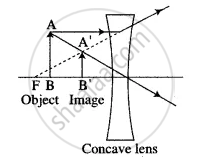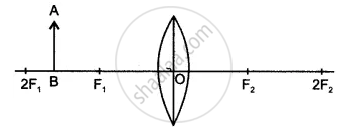Advertisements
Advertisements
प्रश्न
An object is placed in front of a lens between its optical centre and the focus and forms a virtual, erect, and diminished image. Draw a ray diagram to show the formation of the image with the above-stated characteristics.
उत्तर

APPEARS IN
संबंधित प्रश्न
The speed of light in air is 3 × 108 m s-1. Calculate the speed of light in glass. The refractive index of glass is 1.5
A lens forms an erect, magnified, and virtual image of an object. Where is the object placed in relation to the lens?
What are conjugate foci?
Name the lens used as a magnifying glass.
Name the lens for which magnification is always less than 1.
A convex lens produces on a screen an image twice the size of the object. If the position of image and object be interchanged, what will be the magnification then?
Draw a neat diagram to explain the action of a convergent (convex) lens as a reading glass (or magnifying glass). State the characteristics of the image formed.
An object AB is placed between 2F1 and F1 on the principal axis of a convex lens as shown in the diagram. Copy the diagram and using three rays starting from point A, obtain the image of the object formed by the lens.

What is a magnifying glass (or a simple microscope)? Draw a ray diagram to show how a convex lens may be used as a magnifying glass. Where should the object be placed? State three characteristics of the image formed.
(i) Draw a ray diagram to show how the lens can be used as a ‘magnifying glass’? State the nature of the lens.
(ii) In what respect does the image in (i) above different from the image formed by a concave lens?
